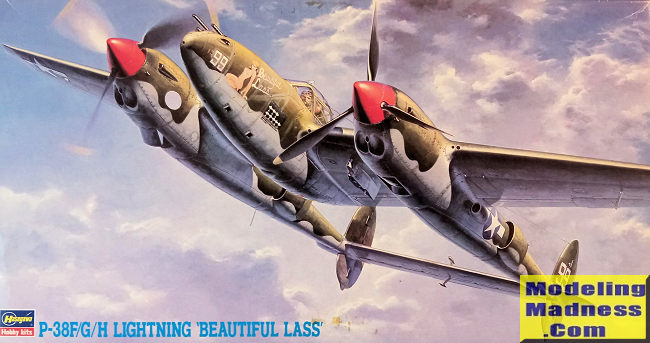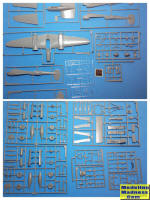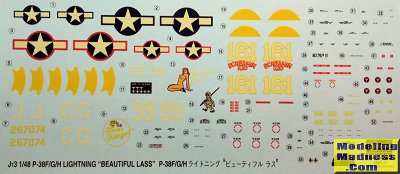
| KIT #: | 09103 (Jt 3) |
| PRICE: | €22 on offer in 2005 |
| DECALS: | Three options |
| REVIEWER: | Spiros Pendedekas |
| NOTES: | 1993 release |

| HISTORY |
The Lockheed P-38 Lightning is an American single-seated, twin piston-engined fighter aircraft that was used during World War II. Developed for the United States Army Air Corps by the Lockheed Corporation, the P-38 incorporated a distinctive twin-boom design with a central nacelle containing the cockpit and armament. Along with its use as a general fighter, the P-38 was used in various aerial combat roles, including as a highly effective fighter-bomber, a night fighter, and a long-range escort fighter when equipped with drop tanks. It was also used as a bomber-pathfinder, guiding streams of medium and heavy bombers, or even other P-38s equipped with bombs, to their targets. Used in the aerial reconnaissance role, the P-38 accounted for 90 percent of the aerial film captured over Europe.
The type was used most successfully in the Pacific Theater of Operations and the China-Burma-India Theater of Operations as the aircraft of America's top aces, Richard Bong (40 victories), Thomas McGuire (38 victories), and Charles H. MacDonald (27 victories). In the South West Pacific theater, the P-38 was the primary long-range fighter of the United States Army Air Forces until the introduction of large numbers of P-51D Mustangs toward the end of the war. It was the only American fighter aircraft in large-scale production throughout American involvement in the war, from the Attack on Pearl Harbor to Victory over Japan Day, with a total of 10,037 units built.
| THE KIT |
 Hasegawa
introduced their very successful 1/48 P-38 series in 1993, with the P-38J
“Virginia Marie” first (Editor’s preview here),
followed (with the addition of some extra/alternative parts) by the “L” and
“F/G/H” versions soon after. The latter is the subject of this preview.
Hasegawa
introduced their very successful 1/48 P-38 series in 1993, with the P-38J
“Virginia Marie” first (Editor’s preview here),
followed (with the addition of some extra/alternative parts) by the “L” and
“F/G/H” versions soon after. The latter is the subject of this preview.
The kit comes in the usual excellent top opening
Hasegawa box, featuring a most attractive box art by Koike Shigeo, portraying
“Beautiful Lass”, piloted by Cpt O’Neil, banking slightly to the left. Upon
opening the box, I was greeted with 128 light gray styrene parts, arranged in no
less than 15 sprues of various sizes, all sealed in two bags. Not all of the
parts are to be used for the build, since some sprues are common with other kit
versions. Molding is superb, with finely engraved panel lines and no apparent
flash.
Twin boom aircraft are complex shaped and this is reflected in the kit layout:
the main wing top half is one piece and contains the upper fuselage, whereas the
lower fuselage part contains the section of the main wing up to the booms, with
separate lower outer wing halves.
Cockpit looks very adequate out of the box, even for today’s standards, as does
the landing gear which features boxed bays. The turbochargers, another prominent
feature of the Lightning, are also nicely represented. The props look also good
and, while featuring separate blades, my experience with Hasegawa is that their
construction will be straightforward. A choice of either bombs or drop tanks is
finally offered.
Clear parts are finely molded and crystal clear, however, unlike the Hasegawa
tradition, they were bagged unsealed together with one set of sprues and they
already exhibited some scratches (I assume, though, that they are separately
bagged in more recent releases). Instructions come to the classic and very nice
hasegawa b/w pamphlet style, being clear and consistent. They contain three pics
of a completed model, a short history of the type and a parts list, with the
construction spread in 15 followable steps.
 Three quite
famous markings options are provided, for a “G”, an “F” and an “H” bird, all in
olive drab over neutral gray. The 1993 decals are superbly printed, have neither
yellowed nor deteriorated at all after almost 30 years and contain a significant
amount of maintenance stenciling, the only “complaint” being the white shade
that is represented as “ivory”. Two good looking chrome plated oval shaped
stickers are also provided, to account for the distinctive mirror polished
panels located at the inner sides of the nacelles.
Three quite
famous markings options are provided, for a “G”, an “F” and an “H” bird, all in
olive drab over neutral gray. The 1993 decals are superbly printed, have neither
yellowed nor deteriorated at all after almost 30 years and contain a significant
amount of maintenance stenciling, the only “complaint” being the white shade
that is represented as “ivory”. Two good looking chrome plated oval shaped
stickers are also provided, to account for the distinctive mirror polished
panels located at the inner sides of the nacelles.
Instructions want you to first assemble the cockpit and attach it onto the lower
fuselage half, then box the main wheel wells, assemble and attach the main
landing gear and trap each subassembly between its corresponding boom halves.
Attachment of the booms to the upper wing half is next, followed by the main
lower fuselage half, the outer wing halves and the one piece horizontal
stabilizer, this seemingly being the area needing special attention during
construction, in order to align everything nicely. Make sure you have added
sufficient weight before attaching the lower fuselage, as the model is a severe
tail sitter candidate, otherwise a supporting stand is provided by the kit.
Next steps deal with nose landing gear installation, main doors and pylons
attachment, as well as bombs or external tanks assembly. Attachment of the nose,
the turbochargers with their cooling intakes and the horizontal stabilizers is
next. Interestingly, Hasegawa wants you to assemble and butt-fit the spinners in
position, then mount the separate blades onto them. Affixing of transparencies
follows, with the final step being installation of either bombs or drop tanks,
ending a construction that does present a certain degree of complexity.
| CONCLUSIONS |
Tamiya came in 2019 with a new tool 1/48 P-38F/G,
complementing it with an “H” and a “J” version in 2020 and 2022 respectively.
Though not cheap, almost everyone who built the Tamiyas came up with praising
words for their buildability and level of detail, so I can only echo those
words.
This deems the venerable Hasegawa kit kind of superseded, but the reality is
that it is a quality kit with correct general shape, offering a very high level
of detail, its only drawback being the complexity of its build. It is definitely
buildable, though, and with some extra attention a gorgeous Lightning will
result. In fact, Hasegawa has to be congratulated for coming up with such a
great kit back in 1993. Regularly reboxed till 2013 with nice schemes and
good decals, if
you are not a beginner and find one at an interesting price, it is still a kit
worth building.
Happy modeling!
July 2022
Copyright ModelingMadness.com. All rights reserved. No reproduction in part or in whole without express permission.
Thanks to
for the review kit. You can find this kit at your favorite hobby shop or on-line
retailer. If you would like your product reviewed fairly and
fairly quickly, please
contact
the editor
or see other details in the
Note to
Contributors.